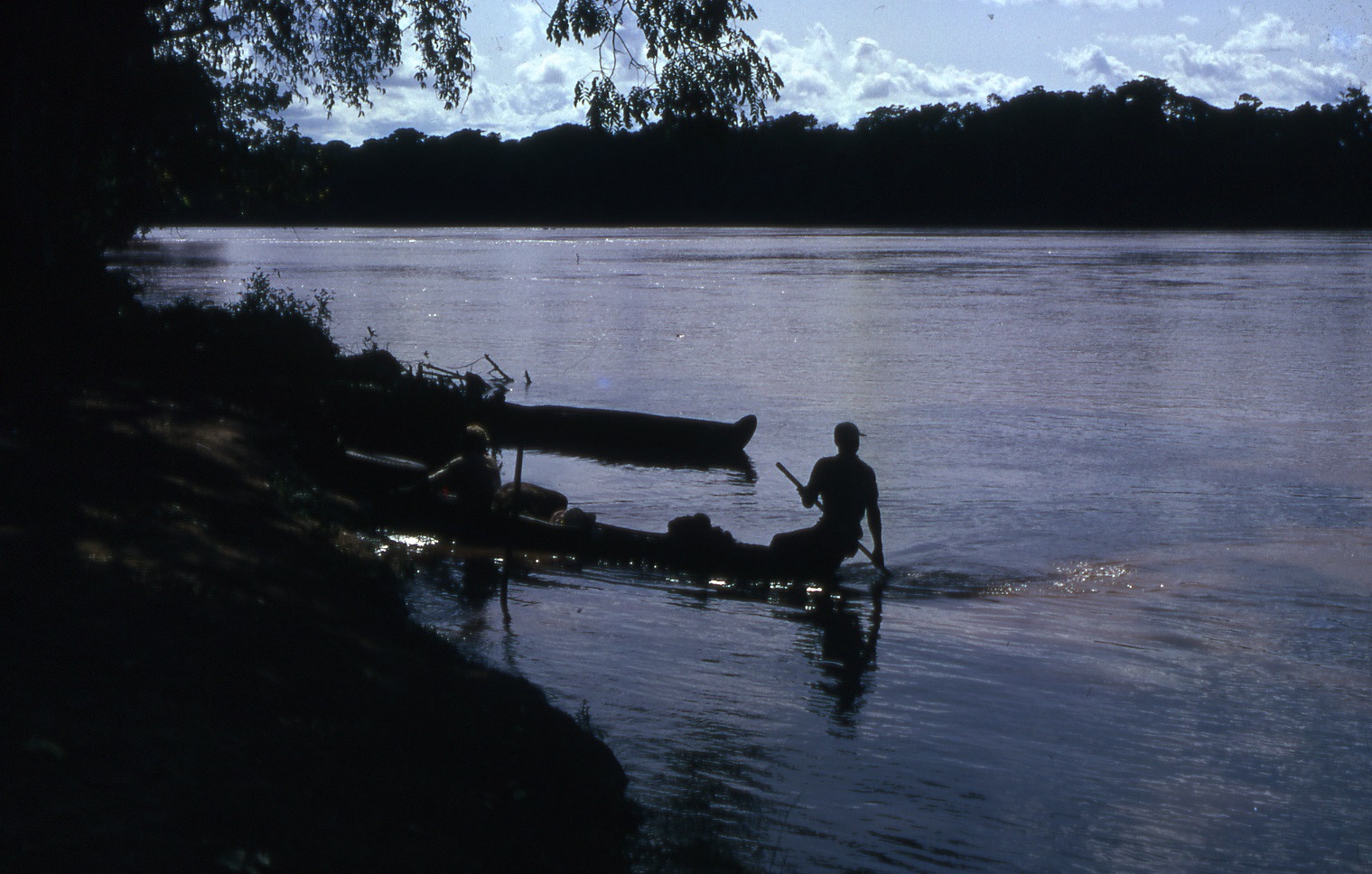Recordings of Bafia: A Bantu language of Cameroon

The Mbam river, Cameroom, Africa. Photo by Gladys Guarisma, 1969. Click on image to access collection.
| Language | Bafia |
| Depositor | Alexandre François, Gladys Guarisma |
| Affiliation | LaTTiCe (CNRS–ENS–Sorbonne nouvelle) |
| Location | Cameroon |
| Collection ID | 0593 |
| Grant ID | LMG0001 |
| Funding Body | ELDP |
| Collection Status | Collection online |
| Landing Page Handle | http://hdl.handle.net/2196/690d1ec2-9ef6-4278-abb7-862e319bf43c |
Summary of the collection
The archive consists in 58 wav files (digitized from 26 original reels), totalling 51h29m:
- 1 – 7: phonology & lexicon: kin terms, plant names; tales, songs
- 8 – 14: noun phrase and general survey
- 9 – 20: verb phrase
- 21 – 25: sentence-based questionnaires
- 26: Folktales (to be soon published at INALCO publications)
Group represented
The Bafia (ɓʌ-kpɑ̄ʔ, sg. ǹ-kpɑʔ) number 30,000 and occupy a region located in the Mbam valley of Cameroon, east of the Bape mountains. The country is a savannah area, surrounded by the rivers Mbam and Sanaga, and interspersed with small forests. The Bafia social organization is based on lineage (patrilineal, virilocal) which usually gives its name to the territory it occupies. The Bafia are polygamous and one marries outside the paternal and maternal lineage. Houses are made of mud, and include a common main room and a space reserved for the lineage leader or the family. Outside are the rooms occupied by women and children, as well as the kitchen, which adjoins the space reserved for housework. The Bafia believe in a creator God (múù.bɛy); they honor ancestors who protect the lineage and who are invoked when needed. The soul (ǹ-ɣay) and the breath (vɛɛmzɛn) are considered to be the source of life. Death happens when they both leave the body. If only the soul goes away while breathing, it is sleep (fi-Ioo) – understood as “little death”.
Language information
Bafia (rɨ̀-kpɑ̀ʔ) is a Bantu language spoken at the northwestern boundary of the domain, belonging to Guthrie’s group A53 (Kpa). Due to its peripheral position, it presents some traits that distinguish it from so-called classical Bantu languages: stretched posterior vowels, labiovelar consonants kp and gb, monosyllabic radical, absence of a locative class.Bafia has 27 consonants at the beginning of a stem (ɓ, ɗ, p, b, f, v, t, d, s, z, c, j, ʃ, ɜ, k, g, kp, gb, w, l, r, y, ɣ, m, n, ɲ, ŋ); these are reduced to 7 in the final (p, s, y, ʔ, m, n, ŋ). Its 11 vowels (i, e, ɛ, a, u, o, ɔ, ɨ, ə, ʌ, ɑ) can be short or long. It is a tonal language, involving four tones: high; low; rising; descending.
According to Guarisma, Bafia is a particularly complex language in terms of phonology and morphology, yet this complexity is counterbalanced by a simple syntactic structure, operating with a small number of elements.
Collection contents
The archive consists in 58 wav files (digitized from 26 original reels), totalling 51h29m.
- vocabulary of about 5000 terms from questionnaires
- stories and folktales
- extensive questionnaires (from Bouquiaux & Thomas 1987), on noun phrases, verb phrases, sentences and themes
- spontaneous narratives (stories, procedural explanations, descriptions of diseases and their treatments, life experience)
- pieces from the oral literature: about 50 proverb-based stories, and a dozen songs
These texts provided the basis to three book publications (Guarisma 1969, 1973, 2000).
Collection history
After a preliminary survey in 1964, Gladys Guarisma carried out her documentation work from 1967 to 1975, in the areas of Bafia, Kiki and Donenkeng. During her surveys, she used the field linguistic questionnaire (Bouquiaux & Thomas 1987), including wordlists, sentence-based questionnaire, and an extensive survey.
Rosmarie Leiderer recorded a corpus of stories with healer Biaback in Nnong and Rionong (Ngam Township); Guarisma transcribed these recordings, and later used them to write her Bafia grammar (Guarisma 2000).
Acknowledgement and citation
Users of the Bafia collection should acknowledge Gladys Guarisma, from CNRS–LaCiTO as the principal investigator and data collector. Alexandre François was in charge of coordinating the collection, in the broader framework of LAVAFLoW (Legacy audio video archival in fourteen languages of the world).
The audio recordings were made possible through the financial support of CNRS–LaCiTO. The ELDP funding helped our research assistant Ms Anne Armand prepare the archive for online display.
To refer to any data from the collection, please cite as follows:
Guarisma, Gladys. 2020. Recordings of Bafia: A Bantu language of Cameroon. Endangered Languages Archive. Handle: http://hdl.handle.net/2196/00-0000-0000-0013-E145-F. Accessed on [insert date here].


